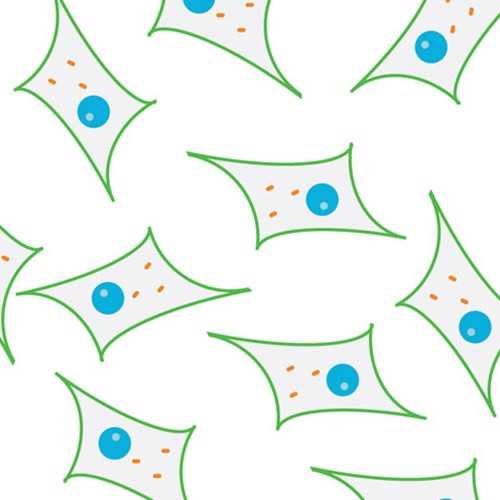Retinal Cell Line (E1A-NR.3)
E1A-NR.3 was established by immortalization of postnatal day 6 rat neuroretinal tissue using the psi2 replication incompetent retroviral vector. As a result, these cells are already resistant to geneticin/G418 and would require an alternative selection marker for transfection studies. These cells were designed not to form tumors in animals.
Read Dr. Seigel's related blog post, On the Road to Retinal Cells »
From the laboratory of Gail M. Seigel, PhD, University of Rochester.
 Part of The Investigator's Annexe program.
Part of The Investigator's Annexe program.
E1A-NR.3 was established by immortalization of postnatal day 6 rat neuroretinal tissue using the psi2 replication incompetent retroviral vector. As a result, these cells are already resistant to geneticin/G418 and would require an alternative selection marker for transfection studies. These cells were designed not to form tumors in animals.
Read Dr. Seigel's related blog post, On the Road to Retinal Cells »
From the laboratory of Gail M. Seigel, PhD, University of Rochester.
 Part of The Investigator's Annexe program.
Part of The Investigator's Annexe program.
Specifications
| Product Type: | Cell Line |
| Name: | E1A-NR.3 |
| Cell Type: | 12S E1A-immmortalized rat retinal cells |
| Accession ID: | CVCL_5I34 |
| Morphology: | Adherent with glial and neuronal morphologies |
| Organism: | Rat |
| Source: | Postnatal day 6 rat neural retina |
| Biosafety Level: | BSL-1 |
| Subculturing: | Split 1:2 when 80% confluent |
| Growth Conditions: | DMEM with 10% calf serum |
| Cryopreservation: | 90% culture medium with 10% DMSO |
| Storage: | -150C |
| Shipped: | Dry ice |
Provider
From the laboratory of Gail M. Seigel, PhD, University of Rochester.
References
E1A-immortalized cell characterization
- Seigel, GM, 1996. Establishment of an E1A-immortalized rat retinal cell culture, In Vitro Cell. Devel. Biol. 32: 66-68.
- Seigel, GM, Mutchler, A.L., and E.L. Imperato. 1996. Expression of glial cell markers in a retinal precursor cell line. Mol. Vis. 2: 2.
- Seigel, GM, Takahashi, M., Adamus, G., McDaniel, T. 1998. Intraocular transplantation of E1A-immortalized retinal precursor cells. Cell Transplant. 7 (6): 559-566.
- Seigel, GM, Sun, W, Wang, J., Hershberger, DH, Campbell, LM, Salvi, RJ. 2004. Neuronal gene expression and function in the growth-stimulated R28 retinal precursor cell line. Curr. Eye Res., 28 (4):257-269.
E1A-immortalized cell utilization
- Identification of pigment epithelium-derived factor protein forms with distinct activities on tumor cell lines. Subramanian P, Deshpande M, Locatelli-Hoops S, Moghaddam-Taaheri S, Gutierrez D, Fitzgerald DP, Guerrier S, Rapp M, Notario V, Becerra SP. J Biomed Biotechnol. 2012;2012:425907. Epub 2012 Jun 4.
- Mouse acetylcholinesterase enhances neurite outgrowth of rat R28 cells through interaction with laminin-1. Sperling LE, Klaczinski J, Schütz C, Rudolph L, Layer PG. PLoS One. 2012;7(5):e36683. Epub 2012 May 3.
- Blue light stress in retinal neuronal (R28) cells is dependent on wavelength range and irradiance. Knels L, Valtink M, Roehlecke C, Lupp A, de la Vega J, Mehner M, Funk RH. Eur J Neurosci. 2011 Aug;34(4):548-58. doi: 10.1111/j.1460-9568.2011.07790.x. Epub 2011 Jul 22.
- Inhibition of reactive gliosis prevents neovascular growth in the mouse model of oxygen-induced retinopathy. DeNiro M, Al-Mohanna FH, Al-Mohanna FA. PLoS One. 2011;6(7):e22244. Epub 2011 Jul 14.
- The effects of commercially available preservative-free FDA-approved triamcinolone (Triesence®) on retinal cells in culture. Zacharias LC, Estrago-Franco MF, Ramirez C, Kenney MC, Takahashi WY, Seigel GM, Kuppermann BD. J Ocul Pharmacol Ther. 2011 Apr;27(2):143-50.
If you publish research with this product, please let us know so we can cite your paper.


